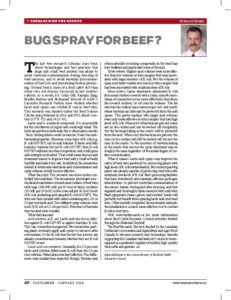Bug Spray for Beef?

This article written by Dr. Reynold Bergen, BCRC Science Director, originally appeared in the January 2014 issue of Canadian Cattlemen magazine and is reprinted with permission.
The last two research columns have been about technologies and best practices that large and small beef packers can adopt to avoid bacterial contamination during dressing of beef carcasses, and to avoid bacterial (re)contamination of beef cuts and trim during further processing. Ground beef is more of a food safety risk than other cuts, for reasons discussed in last month’s column. As a result, Dr. Colin Gill, Xianqin Yang, Madhu Badoni and Mohamed Youssef of AAFC’s Lacombe Research Station have studied whether lactic acid sprays can combat E. coli in beef trim. This research was funded under the Beef Science Cluster and published in 2012 and 2013 (Food Control 25:717-722 and 34:13-16).
Lactic acid is a natural compound. It is responsible for the sour flavor of yogurt and sourdough bread. The body also produces lactic acid; this is what makes muscles “burn” during intense work or exercise. It also has antibacterial properties. However, some types of E. coli (e.g. E. coli O157:H7) can be acid tolerant. If lactic acid kills harmless bacteria but not E. coli O157:H7, then E. coli O157:H7 will have no other competitors, and could grow and multiply unchecked. That could mean that an acid treatment meant to improve beef safety could actually backfire and make it less safe. In addition, the researchers needed to determine what lactic acid concentrations and spray volumes would be most effective.
What They Did
This research was done under controlled lab conditions. The researchers inoculated muscle, fat and membrane-covered meat surfaces of beef trim with high (100,000 cells per 10cm2 of trim), medium (10 cells per 10cm2) or low (1 cell per 10cm2) levels of E. coli (including acid-adapted E. coli O157:H7). The trim was then sprayed with water containing 0%, 2% or 5% lactic acid. Two different spray volumes were used (0.02 ml or 0.5 ml per cm2). Numbers of bacteria that survived were counted.
What They Learned
Acid tolerance of E. coli: Lactic acid was just as effective against E. coli O157:H7 as against harmless E. coli. This was somewhat unexpected. But remember, packing plants routinely apply acid sprays to carcasses after evisceration. So the E. coli that survive that process are already somewhat acid tolerant, whether they are E. coli O157:H7 or not.
Lactic acid concentration: Generally, the 5% lactic acid solution killed more E. coli than the 2% solution. Water alone was least effective. The differences were smaller than expected, though. Proteins and other naturally occurring compounds in the beef may have buffered and inactivated some of the acid.
Spray volume: Higher spray volumes were more effective than low volumes in trim samples that were inoculated with large numbers of E. coli. But the volume of spray used didn’t matter very much in trim samples that had been inoculated with small numbers of E. coli.
Meat surface: Spray treatments eliminated E. coli from meat surfaces covered with a shiny, smooth membrane of connective tissue more effectively than from fat-covered surfaces or cut muscle surfaces. The fat and muscle surfaces have microscopic cuts and cracks where bacteria can hide and be protected from the acid sprays. This partly explains why larger acid volumes were only more effective in trim samples that had high levels of E. coli. When a lot of bacteria are present, many are on the surface and can be washed off completely, but the bacteria hiding in the cracks will be protected from the acid. When very few bacteria are present, the ones on the surface will still be washed off, but not the ones in the cracks. So the numbers of bacteria hiding in the cracks that survive the spray treatment may be roughly the same regardless of the initial degree of surface contamination.
What it Means
Lactic acid sprays may improve the safety of beef trim produced by processing plants with high levels of E. coli contamination. But modern packing plants are already capable of producing beef trim with extremely low levels of E. coli. Beef processing facilities that have introduced and maintain effective pathogen interventions to prevent microbial contamination of the carcass before, during and after dressing, and that regularly and thoroughly clean conveyor belts and other fixed equipment, knives, gloves, and worker’s hands will probably not benefit from spraying lactic acid onto beef trim. Other recently-completed cluster research indicates that irradiation is a much more effective tool to combat E. coli in beef trim.
Click here to subscribe to the BCRC Blog and receive email notifications when new content is posted.
The sharing or reprinting of BCRC Blog articles is typically welcome and encouraged, however this article requires permission of the original publisher.
We welcome your questions, comments and suggestions. Contact us directly or generate public discussion by posting your thoughts below.